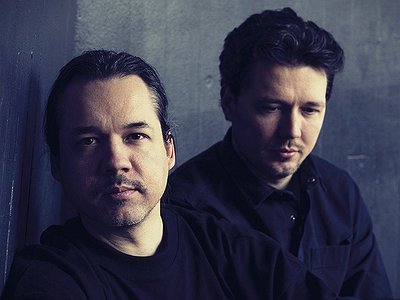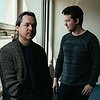Part 1
Name: Sebastian & Daniel Selke aka CEEYS
Nationality: East German
Occupation: Composer, producer, musician
Current Release: Hiddensee on Neue Meister
Recommendations: Der Traumzauberbaum (1980) is a beautiful collection of so-called ‘Geschichtenlieder’ - which would translate to “song narratives” - created by Reinhard Lakomy and Monika Ehrhardt in collaboration with Angelika Mann and Veronika Fischer. Also check out these: Fifty shades of grey, a photo sequence by David Navarro and Martyna Sobecka in which they photographed postwar estates all across Central and Eastern Europe, finding strange, stark beauty in these concrete giants.
If you enjoyed this interview with Sebastian and Daniel of CEEYS, be sure to visit their beautifully designed 'digital playground', for more information, resources and music.
When did you start writing/producing music - and what or who were your early passions and influences? What is about music and/or sound that drew you to it?
S: I went on the creative path early on, practicing ice-skating. In the former GDR, this was the best artistic combo between music, dance, acting and sports. But when a doctor diagnosed back issues caused by the hard jumps on ice, my mother - who herself was an actress - and I decided to switch our ‘hobby‘. It was at the age of seven that we started attending the local music school to learn various instruments. After violin and piano, the cello soon became my favourite.
From the beginning mom said: this time, we will make it work and bring this to a successful ending (laughs).
D: I was freezing from the first moment I saw Sebastian running on ice and showed my lack of interest by just crawling instead of skating. When Sebastian picked up music and started playing the cello, I could finally breathe freely and it did not take long until I fell in love with the piano.
S: We had always listened to a lot of classical music from solo works to chamber music and symphonic orchestral pieces.
D: Growing up in the communist-era GDR, the Russian masters like Mussorgsky, Shostakovitch and Prokofiev had a strong impact.
S: We still like their approach that combines epic emotions with complex rhythmic structures.
D: There were also GDR composers such as Reinhard Lakomy who gave us the full spectrum of music to stimulate our imagination – in Der Traumzauberbaum we were first confronted with the concept of pop music, combining acoustic instruments and synthesisers wrapped up in amusing narratives.
S: Eventually we came across the secret, less conventional record collection of our parents - this is where we discovered all the inspiring works by Pink Floyd, Vangelis, Isao Tomita, Peter Gabriel, and Keith Jarret. While we continued to love the old eastern masters, this provided a fresh source of inspiration for our music.
For most artists, originality is first preceded by a phase of learning and, often, emulating others. What was this like for you? How would you describe your own development as an artist and the transition towards your own voice? What is the the relationship between copying, learning and your own creativity?
S: As two brothers making music in a small flat of a concrete building, at the early stages we were very much inspired by one another, following each step on the other one’s path in discovering our instruments’ language. I often simply listened to Daniel playing the piano and then, after a while, I replied to his patterns and phrases on the cello.
D: Yes that was really fun – and having fun was essential during those harder classical music lessons. And yes, we did suffer quite a bit training classical music. Today we know that there are many good sides to our training too, because we learned how music worked in the past and of course this is where we mastered our skills. So in the end, I think this just brought us closer together and welded us into the duo we are today.
What were your main compositional and production challenges in the beginning and how have they changed over time?
S: One of the biggest challenges I remember was when we first listened to our music on record. I cannot really describe the feeling but for our musical self-conception, this was groundbreaking. This was even before we s started writing our own music.
D: We are still trying to recreate this feeling we had when first listening to our recordings. That is why our recording process is a work in progress. For HIDDENSEE, we had the opportunity to re-record our tracks with the help of some analogue gear from Nils Frahm‘s Studio in Saal 3 at Funkhaus Berlin.
[Read our Nils Frahm interview]
S: It was like going back to our early childhood when we went to the Funkhaus’ kindergarten for employee’s children – our father worked in these legendary buildings during the 80s. And we are still trying to find this special atmosphere again.
What was your first studio like? How and for what reasons has your set-up evolved over the years and what are currently some of the most important pieces of gear for you?
S: We started with a Stern Rekorder by RFT. During the 90s, we simply used a portable recorder. For some reason, a computer-based production process never really worked out for us.
D: To this day, we use our computer as a recording or editing tool only and avoid plugins.
S: Improvisations are an integral part of our practice – we rehearsed our latest album like you would do for a theater play and then recorded three takes that were similar to live shows. In the end, we took the best parts and edited them.
The quality might have been better had we recorded cello, piano and electronics separately with overdubs. But for us it is more about capturing the atmosphere of a given moment, like a field recording. When you listen to HIDDENSEE, you bear witness to something that cannot be repeated.
D: For us, it is all about remembering those moments.
How do you make use of technology? In terms of the feedback mechanism between technology and creativity, what do humans excel at, what do machines excel at?
S: We even get inspiration from computers. I do not mind Softsynths or libraries and I enjoy watching hilarious videos that show you how to build a trap track in under 10 minutes. The technology surrounding us is definitely inspiring but in the end, Daniel and I seek to translate these techniques to our acoustic instruments cello and piano. And sometimes we do the exact opposite and write a super long and slow track.
D: We love to share funny producer videos with each other and are constantly competing in trying to find even more hilarious ones. But in the end, we communicate through our music.
S: I mean, having fun is very important but of course we also try to understand and make the best use of our vintage equipment, our synthesisers from the former Soviet Union and the GDR. It is exactly the unique, slightly scruffy quality of these instruments that we find charming.
D: It is exciting to see how those dinosaurs adapt to a contemporary setting.
Production tools, from instruments to complex software environments, contribute to the compositional process. How does this manifest itself in your work? Can you describe the co-authorship between yourself and your tools?
S: Whether we are using a pencil or a computer equipment, it all comes down to one idea: bringing our sketches to life. I need to know what each screw within the system is doing to be able to use it when I am trying to create a specific feeling.
D: Tools have to be ready at hand for any given musical situation but need to be used subtly to keep the emotional dimension.






